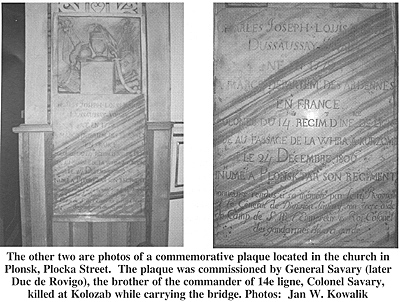Action at Kolozab
24 December 1806
Conclusions and Sources
by Robert Goetz, USA
| |
Conclusions
The other two are photos of a commemorative plaque located in the church in Plonsk, Plocka Street. The plaque was commissioned by General Savary (later Duc de Rovigo), the brother of the commander of 14e ligne, Colonel Savary, killed at Kolozab while carrying the bridge. Photos: Jan W. Kowalik Casualties from Lefranc’s brigade are included in this total, although Lefranc’s regiments were engaged to the north at Sochocin against the Tenguinsk musketeers. The 14th ligne had ten officers killed and wounded in the crossing of the Wkra of 24 December. The other French regiments at Kolozab do not appear to have suffered any officer casualties in the action.
[5]
Russian losses are not stated in sources but seem to have been substantially lighter. The action at Kolozab is interesting in that both sides achieved their objective to some degree, although neither side is immune from criticism. Barclay’s position was a difficult one, and clearly he was not expected to do more than delay the French. However, given the proximity of the ford at Sobieski (and indeed others farther downstream), the failure to deploy infantry at the ford or to cover his left seems a serious omission. A battalion of Tenguinsk, it seems, would have been sufficient to slow Lapisse sufficiently to hold the position longer and prevent the loss of the artillery without overly weakening the central reserve between the two posts he was defending.
On the French side, Savary and his men demonstrated ample bravery and élan, receiving high praise from Desjardin in the report of the battle and Napoleon in his 45th bulletin. However, the wisdom of Savary’s actions is questionable. At Borkowo a turning movement alone was sufficient to dislodge the defenders and deliver the bridge into the hands of the French with an insignificant loss of life. The substantially higher losses suffered at Kolozab are the direct result of the storming of the bridge, an action that in retrospect seems reckless and wholly unnecessary. Certainly the French could have achieved as much with fewer losses had Savary waited to storm the bridge after Lapisse arrived on Barclay’s flank.
[1] Sources do not detail the number of battalions of 3rd Jäger at Kolozab. French reports indicate a strength consistent with two battalions and while it is possible that a third battalion was present, it seems more likely that the remaining battalion was at Borkowo. Dorokhov had three battalions at Borkowo on 18 December, two from 1st jäger and one from 3rd jäger. It is
possible that Dorokhov had a second battalion under his command on the 24th, although French reports note only a single battalion. The presence of at least 2 battalions of 1st jäger at Sochocin on the 24th makes it likely that the battalion at Borkowo was from 3rd jäger.
[2] Strength estimates are not reported for these forces, but the rough estimates can be based on typical strengths for similar units at this point in the campaign.
[3] Russian sources are imprecise regarding artillery dispositions, but consistently note that the horse artillery was in the advanced positions on the Wkra. French reports indicate 6 guns at Sochocin, “many” at Kolozab (6 were captured here), and 5 at Borkowo. Considering the 1/2 battery of horse artillery at Czarnowo, this suggests that the horse artillery batteries from 2nd and 4th divisions were evenly distributed with a half battery at each of the four points, which would mean that Davydovskii’s battalion(s) were accompanied by a half battery.
[4] Desjardin’s report states that Savary was ordered to attack at two points, at the bridge and a short distance upstream. However, Desjardin describes Savary as issuing the orders for the actual storming of the bridge. Desjardin warmly praises Savary’s actions, as does Napoleon in his bulletin. By contrast Commandant Lechartier, writing a century later, condemns the assault as foolish and wasteful.
[5] Officer casualties are reported for 105th ligne as 9 killed and wounded during the period 24-26 December. Officer casualties among the other regiments (killed and wounded) at Golymin on the 26th were as follows: 14th ligne – 5; 44th ligne - 6; 16th légère – 8. This suggests that all or most of the officer casualties suffered by 105th ligne were sustained at Golymin and that casualties on the 24th were light in all regiments but 14th ligne. Smith, Napoleon’s Regiments. Foucart, 433.
“Le Général Milhaud au Général Belliard, Aux avant-postes de Pomichowo, 22 décembre 1806, 2 heures der demie du matin” in Foucart (see below), p. 370-71.
Bennigsen, Leonty Leontyevich, count von, Mémoires du Général Bennigsen, Vol. 1 (1908)
Action at Kolozab 24 December 1806
|
 French casualties at Kolozab are given as 33 dead, 225 wounded from Desjardin’s division. There do not appear to have been any casualties in Milhaud’s brigade, which was only involved in the pursuit. Lapisse’s brigade incurred the majority of these casualties with 14th Ligne suffering the most.
French casualties at Kolozab are given as 33 dead, 225 wounded from Desjardin’s division. There do not appear to have been any casualties in Milhaud’s brigade, which was only involved in the pursuit. Lapisse’s brigade incurred the majority of these casualties with 14th Ligne suffering the most.